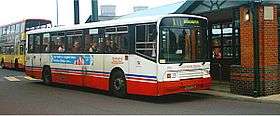Kelvin Central Buses
Kelvin Central Buses Ltd was a bus operating subsidiary of the Scottish Bus Group formed in July 1989 from the merger of Kelvin Scottish and Central Scottish in preparation for privatisation, and operated until July 1998 when it became First Glasgow (No.2) Ltd.
Operation
From its head office in Traction House, Motherwell, Kelvin Central had an operating area stretching from Loch Lomond in the west, the Campsie Fells in the north, Shotts to the east and Strathaven to the south.
Kelvin Central was the largest operator in Lanarkshire and Dunbartonshire, and was responsible for urban, rural and interurban services in and around the towns of Dumbarton, Kirkintilloch, Motherwell, Hamilton, Airdrie, Cumbernauld and much of Glasgow.
On formation of the company, depots were located in Old Kilpatrick, Milngavie, Kirkintilloch, Kilsyth, Stepps, Cumbernauld, East Kilbride, Airdrie, Motherwell, Wishaw and Hamilton. However, Wishaw and East Kilbride were to close very soon after the merger, and at that time the company would largely withdraw from services around East Kilbride.
History
Kelvin Central Buses Ltd was formed when Central Scottish changed its legal company name in preparation for the merger with Kelvin Scottish in 1989. The new merged company would have a difficult birth. Central's network had been paralysed for weeks due to strike action, and by the time the dispute was resolved a number of new operators had stepped in to take on the abandoned services. Whereas Kelvin had been one of the more successful of the Scottish Bus Group subsidiaries, Central was financially weakened, suffered from heavy competition and burdened with a large debt.
Despite the head office of the new company remaining at the former Central headquarters in Motherwell, Kelvin management assumed control and swiftly embarked on turning the company around. Immediately after the merger, services, vehicles and depots were rationalised and a vibrant red and cream livery was introduced for the bus fleet. It could be argued that the depot closures at East Kilbride and Wishaw were management retaliation for the strikes, as they were widely viewed at the time as the most militant in the operation.
The company restricted itself to purchasing only used vehicles and the company readied itself for the transition to the private sector. Upon the break-up and privatisation of the Scottish Bus Group it was rumoured that Stagecoach was the preferred bidder for Kelvin Central until they had an opportunity to examine the company's accounts.
In 1991 the company passed to its management and employees, but due to the company's debt and continued operating losses, the purchasers did not have much money to invest.
Many of the smaller independent operators that competed heavily with Kelvin Central were successfully purchased, paving the way for Kelvin Central to become the dominant operator once again in much of Lanarkshire but also giving it a rather mixed and sometimes rather elderly fleet. Stagecoach's Magic Bus operation in Glasgow was also purchased, bringing in mainly Stagecoach-standard Volvo B10M-55/Alexander PSs and Alexander Dash-bodied Dennis Darts, and the company slowly returned to profitability, with new vehicle purchases starting again in 1993, these were mainly Volvo B10B/Alexander Striders, Volvo B6/Alexander Dashes and Volvo Olympian/Alexander Royales. The choice of the Volvo/Alexander combination probably came from the fact that Kelvin found the PSs very good buses.
The neighbouring Glasgow city operator, Strathclyde Buses, was itself employee-owned. At that time, Stagecoach Western Scottish were poised to launch a network of Glasgow city services under the Stagecoach Glasgow banner, competing directly with Strathclyde Buses and Kelvin Central. Weeks before these new services were due to commence, Stagecoach acquired a 20% stake in SB Holdings (Strathclyde Buses and Kelvin Central Buses parent group) and the "bus war" was averted. Kelvin Central purchased the vehicles intended to be used by Stagecoach Glasgow and took over the planned new services.
Further rationalisation of vehicles, depots and services took place between Strathclyde Buses and Kelvin Central, which by that time had begun trading as KCB Network.
However, while the Monopolies and Mergers Commission cleared the Strathclyde/Kelvin Central merger, it found the Stagecoach stake in the combined company to be against the public interest. It ordered Stagecoach to divest its 20% share in the firm early in 1995.
The ownership issue was not to be resolved until June 1996, however, when FirstBus agreed to purchase SB Holdings, including the 20% Stagecoach share, for £110m.
A new all-over red livery was adopted for the combined company, and the KCB Network trading name was replaced with Kelvin, and later First Kelvin.
In 1998, Kelvin Central Buses Ltd was renamed First Glasgow (No.2) Ltd, trading as First Glasgow.
External links
- First Glasgow website
- Competition Commission report into Strathclyde Buses/Kelvin Central merger
- Competition Commission report into Stagecoach/SB Holdings situation
- Competition Commission report into FirstBus take over of SB Holdings
- Kelvin Central page at Central SMT enthusiasts website

